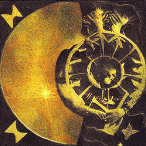

Lazarus
Senior Members-
Posts
366 -
Joined
-
Last visited
About Lazarus
- Birthday 09/07/1930
Profile Information
-
Location
Scottsdale, AZ
-
Interests
Making physics rational
-
College Major/Degree
Dropped out of school in kindergarden, Oops, that's next lifetime.
-
Favorite Area of Science
Fundemental physics
Lazarus's Achievements

Atom (5/13)
-16
Reputation
-
Lazarus started following How is Bell’s Inequality converted to the CHSH inequality?
-
Bell’s inequality is S = P(a,b)-P(a,d)+P(c,b)+P(c,d) <= 2, which is calculated as S = a*b – a*d + c*b + c*d <= 2 The CHSH version is: E = (N11 + N00 - N10 -N01) / (N11 + N00 + N10 + N01) S = E1 - E2 + E3 + E4 / E1 + E2 + E3 + E4 <= 2 N11 is the number of correlations, etc E is the Correlation Coefficient There appears to be a significant difference between Bell’s and CHSH’s inequalities. For comparison, converting the Correlation Coefficient to Probability makes it possible to enter the values directly into Bell’s Inequality. The conversion to Probability is the Correlation Coefficient divided by 2 then adding .5. Using the much mentioned values for E of +.707, -.707, +.707 and +.707 as a, b, c and d, Bell’s Inequality is calculated as S = -.8535*.8535 – ( .8535*-.8535) + .8535*.8535 + .8535*.8535 = -.728 + .728 + .728 + .728 = 1.456. So using the real Bell’s Inequality, there is no violation. Please explain the justification for the CHSH Inequality.
-
Good to hear from you Tom. You have been a great help correcting my many jumps to conclusions. Why do I need dimensions when dealing with proportions ?
-
These two statements from your suggested article seem to say the rotation matches the visible mass. “Arthur Kosowsky, Department of Physics and Astronomy, University of Pittsburgh, 3941 O'Hara Street, Pittsburgh, PA 15260, USA November 9, 2016• Physics 9, 130 A universal law shows that the rotation of a disk galaxy is determined entirely by the visible matter it contains, even if the disk is mostly filled with dark matter.” --------- “From the 153 galaxies, the authors derive about 2700 data points of the predicted and actual acceleration at different radii within each galaxy’s disk. When plotted against each other, the predicted and measured accelerations trace out a tight relation: if you know the centripetal acceleration at a given radius expected from the gravity of the visible matter in the disk, you then also know the actual acceleration at that radius, even though in many cases it is mostly determined by the dark matter. “ --------- Also, if you let me arrange the stars in the galaxy, I will make the visible mass match the rotation.
-
Thank you for pointing that out. It certainly does complicate the calculation. The contribution from the outer stars would cause the stars close to the center to have a lower velocity but the outer stars would be affected less. That would leave the outer stars with a higher velocity than the inner stars. To reach equal velocities, the density of the stars would have to decrease more rapidly. It appears there is some disagreement about the structure of galaxies. Here is an article that seems to contend that the structure can match the velocities. https://www.sciencedaily.com/releases/2016/09/160921085052.htm Date: September 21, 2016 Case Western Reserve University Summary: Researchers have found a significant new relationship in spiral and irregular galaxies: the acceleration observed in rotation curves tightly correlates with the gravitational acceleration expected from the visible mass only. The discovery may alter the understanding of dark matter and the internal dynamics of galaxies.
-
Doesn't that imply that a spherical configuration would cause the outer mass to affect the star?
-
What if you considered a slice of the sphere? What force would apply to the star?
-
Excellent point. Is there a convenient place to find the distribution of the stars and gas?
-
The primary evidence for Dark Matter is the observation that many distant galaxies have stars rotating at pretty much the same velocity. Perhaps the structure of the galaxies can explain the phenomena. A galaxy with most of the matter near the center of the galaxy would have the orbiting outer stars with a lower velocity than the inner stars. However, with a disc shaped galaxy with evenly spaced stars, the outer stars would have a higher velocity than the inner stars. The reason is that the orbit of a star is not affected by evenly spaced stars further from the center of the galaxy. The calculation of the relative velocities of stars in the disc is: A is the gravitational acceleration. F is the centripetal force. M is the total mass of the stars closer to the center of the galaxy. V is the velocity of a star. D is the distance from the star to the center of the galaxy. M = D^2 A = M/D^2 F = V^2/D A = F M/D^2 = V^2/D D^2/D^2 = V^2/D 1 = V^2/D V^2=D V = D^.5 So the velocity of the stars increases by the square root of the distance. At some configuration of the stars the velocity would be the same for all stars. One example is a tapered disc with the density of the stars inversely proportional to the square root of the distance from the center of the galaxy. That causes mass to become M = D and V^2 = 1. All the stars now have the same velocity. Is this correct?
-
This is a wild guess at the source of the Sonic Weapon in Cuba. Possibly strong low frequency radiation could affect the human brain. A pure frequency should be too disbursed to do any damage but a using two close frequencies could create a beat frequency of 10, 20000 hz or any other frequency. The radiation could be generated in a small beam aimed at a single individual. It might be recognized as sound. Is this feasible?
-
The link to the paper is: http://www.optics.rochester.edu/workgroups/lukishova/QuantumOpticsLab/2010/OPT253_reports/Josh_Lab1.pdf The link to the paper is: http://www.optics.rochester.edu/workgroups/lukishova/QuantumOpticsLab/2010/OPT253_reports/Josh_Lab1.pdf
-
The CHSH Inequality is valid. The logic of the experiment is correct. The alignment of the physical experiment is wrong. The alignment of the 2 polarizers is from a angle of zero from vertical. The incoming photons must be aligned with the vertically polarized photons at zero degrees and the horizontally polarized photons at 90 degrees. That is NOT the way the experiment IS ACTUALLY DONE. There is a ton of information about the alignment of the 2 polarizers but there are really 4 alignments. The 2 polarizers can be rotated to set the alignment. The BBO crystals can be rotated to set their alignment. The Quartz Wave Plate can be rotated to set the alignment of the source beam. The BBO crystals must be aligned with the output of the Quartz Plate so that both crystals are at 45 degrees from the output of the Quartz Plate. The hack is that the Quartz Wave Plate is NOT ALWAYS ALIGNED so that the "vertically" polarized photons are vertical at zero degrees. Here is evidence that the Quartz Wave Plate aligns the beam incorrectly, from the description of the CHSH experiment by Joshua Geller of the University of Rochester. THE ALIGNMENT OF THE POLARIZERS The Clauser-Horne-Shimony-Holt inequality considers a convex combination of the correlation function above, using the four angle combinations, as displayed here. S = |E(a,b)-E(a,b')|+|E(a',b)+E(a',b')|, where S is the quantity that is bounded for a classical system operating according to a local hidden variable theory, we must have |S| <= 2. Note: however, that for choices of angle a = -Pi/4, b = -Pi/8, a' = 0, b' = Pi/8, the predicted value of S from the above derivation starting with the rotationally invariant entangled Bell state that descries our setup of signal/idler entangled photon pair is S = |-1/2^.5 - 1/2^.5| + |1/2^.5 + 1/2^.5| = 2*2^.5. So the quantum mechanical description of our system violates the inequality. QUARTZ PLATE ALIGNMENT OF THE SOURCE BEAM To achieve consistent coincidence counts of as many polarizations angles as possible of polarizers A and B, the quartz plate is rotated along its horizontal and its vertical axis, and then the coincidence counts are recorded for multiple polarizer positions. We used a = b = 0, a = b =45, a = b = 90 and a = b = 135 degrees. We plot the results of these measurements against the angular positions of the quartz plate, and choose the orientation of the quartz plate at the angles where the set of four curves are nearest to equal. We then fix this orientation for the experiment. This shows that the Down Converted photons are NOT ALWAYS aligned vertically and horizontally. That is how the inequality is violated. Do you see an error in this?
-

Bell's Inequality is not valid for negative numbers
Lazarus replied to Lazarus's topic in Speculations
OK, I'll go away. But before I go, I will make one last attempt to get someone to refute this simple proposition. Bell's Inequality is not valid for negative numbers. CHSH violates Bell's Inequality with a negative number in it. Therefore, CHSH is invalid.- 39 replies
-
-1
-

Bell's Inequality is not valid for negative numbers
Lazarus replied to Lazarus's topic in Speculations
I assume you do not agree with either of those statements. -

Bell's Inequality is not valid for negative numbers
Lazarus replied to Lazarus's topic in Speculations
I will never convince you and you will never convince me that a physical experiment with a math error is valid. Do we agree that a negative number is put into Bell's Inequality and agree that lots of negative numbers can violate the inequality? Thanks to all of you. I really appreciate your replies.




